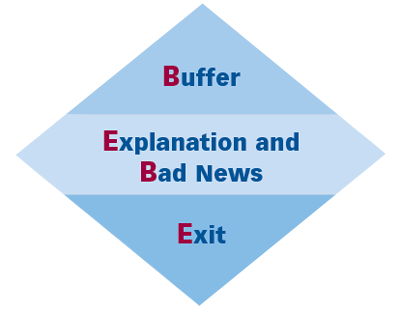No one likes to be the bearer of bad news, but it’s a role you’ll likely have to take on at some point in your career.
Delivering bad news in writing presents an especially thorny communication situation. On the one hand, you must express the news accurately, leaving your reader with a clear understanding of the issue, problem, action, or outcome. On the other hand, you must express the news tactfully if you are to maintain (or gently end) the relationship.
This eTip will help you achieve both of these objectives.
How should I organize my message?
When you break bad news, don’t start with the bad news. Instead, begin with a buffer that connects you to your reader. Then provide an explanation leading up to the bad news. Finally, exit by focusing on the future.
Use the BEBE strategy: Buffer + Explanation + Bad news + Exit.

Note: If the bad news you are sharing is minor, or if your reader expects it, you may choose a more direct approach by stating the news right away.
How can I soften the blow?
Use your buffer statement to cushion the blow of bad news and establish a voice of reason and respect. Try one or more of these strategies:
- Thank the reader for a contribution or past business.
Thank you for your bid to design and develop Everson's new eight-acre city park.
- Agree on a point.
Thanks for suggesting that Rankin create remote work possibilities for all staff. I've been intrigued with this work concept for some time.
- Express understanding.
We have finished investigating your concerns about the ATV16 drives that you installed for American Linc Company. We do understand that the drive and serial-link failures have inconvenienced both you and American Linc.
- Pay a compliment (but not a condescending one).
Your bid was competitive for several of the criteria outlined in our original RFP.
How can I use the right tone of voice?
Strive for a neutral tone of voice, even if you harbor negative feelings about the subject or situation. Strong negative emotion never comes across well in writing. Make sure your emotions are in check when you write your message.
How can I respect my reader’s feelings?
Be honest, but not blunt. Make sure you explain why a certain action or decision is necessary. Use pronouns such as we and our to connect with the reader. Avoid you and your in negative contexts because they can create an accusatory tone.
Notice how the you and your in this example pits the writer against the reader.
Blunt and Accusatory
Youngstown Microchip used to know how to pack an order, but now you can’t get a single shipment out on time with the right stuff in it. You should fire your warehouse supervisor, Nick Luther, before Rankin Technologies fires you.
Honest and Respectful
Rankin Technologies has always valued our partnership with Youngstown Microchip. Within the last six months, however, late shipments and incorrectly filled out orders have impacted our working relationship. We need to solve these problems, or we’ll need to find another vendor.
|